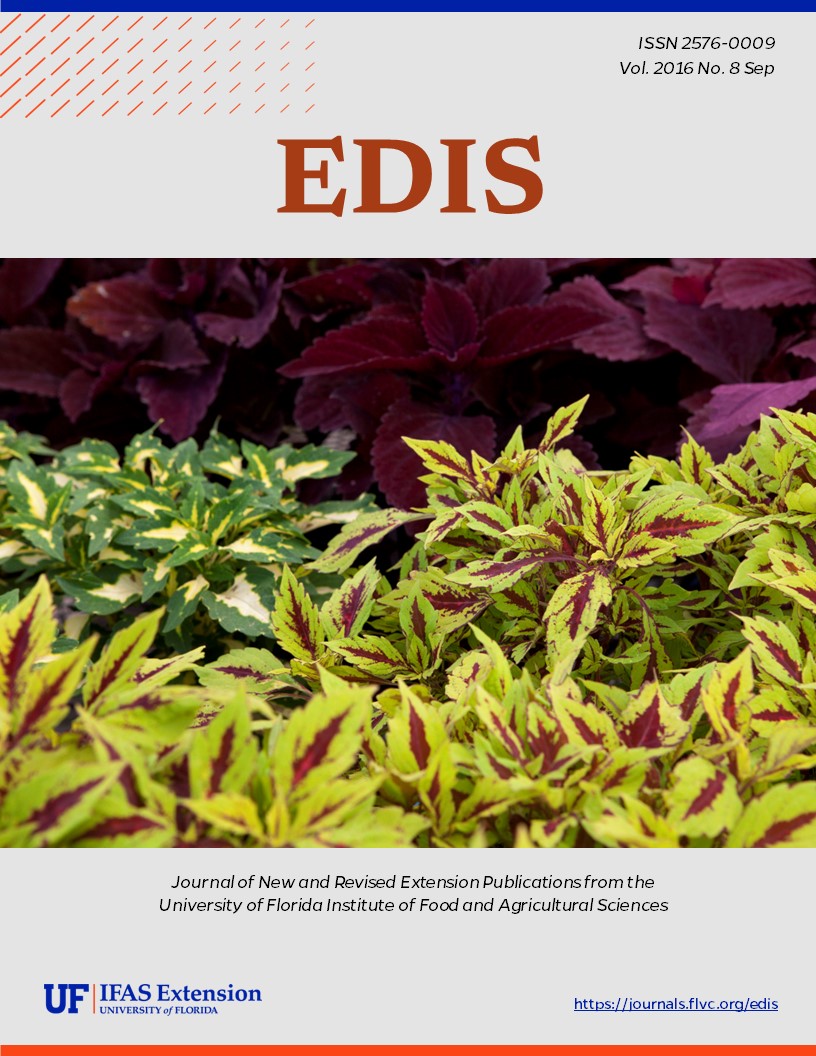Abstract
This EDIS publication is an alternate version of a page published first on the Featured Creatures website. The Featured Creatures collection provides in-depth profiles of insects, nematodes, arachnids and other organisms relevant to Florida. These profiles are intended for the use of interested laypersons with some knowledge of biology as well as academic audiences. This 5-page fact sheet that discusses the tuliptree scale was written by Matthew Borden and Adam Dale, and published by the UF Entomology and Nematology Department, October 2016.
References
Bartlett BR. 1961. The influence of ants upon parasites, predators, and scale insects. Annals of the Entomological Society of America 54: 543-551. https://doi.org/10.1093/aesa/54.4.543
Burns DP, Donley DE. 1970. Biology of the tuliptree scale, Toumeyella liriodendra (Homoptera: Coccidae). Annals of the Entomological Society of America 63: 228-235. https://doi.org/10.1093/aesa/63.1.228
Burns DP. 1964. Formicidae associated with the tuliptree scale. Annals of the Entomological Society of America 57: 137-139. https://doi.org/10.1093/aesa/57.1.137a
Burns DP. 1968. The Impact of tuliptree scale feeding on its host, yellow poplar. Ohio State University.
Frank JH, Foltz JL. 1997. Classical biological control of pest insects of trees in the southern United States: A review and recommendations. Forest Health Technology Enterprise Team. Morgantown, WV.
García Morales M, Denno BD, Miller DR, Miller GL, Ben-Dov Y, Hardy NB. 2016. ScaleNet: A literature-based model of scale insect biology and systematics. Database. doi: 10.1093/database/bav118. http://scalenet.info. ScaleNet (26 August 2016) https://doi.org/10.1093/database/bav118
Hoover, G. 2006. Tuliptree scale. Penn State University Extension publication TS-30. http://ento.psu.edu/extension/factsheets/tuliptree-scale (26 August 2016)
Kondo T, Williams DJ. 2008. Neotype designation and redescription of Toumeyella liriodendri (Gmelin) (Hemiptera: Coccoidea: Coccidae). Journal of Insect Science 8: 56. https://doi.org/10.1673/031.008.5601
Krischik V, Davidson J. 2007. Tuliptree scale. IPM of Midwest landscapes: Pests of trees and shrubs. University of Minnesota.
Sharma S, Oi D, Buss E A. 2013. Honeydew-producing hemipterans in Florida associated with Nylanderia fulva (Hymenoptera: Formicidae), an invasive crazy ant. Florida Entomologist. 96: 538-547. https://doi.org/10.1653/024.096.0219
Simpson, JD, Lambdin, PL. 1983. Life history of the tuliptree scale, Toumeyella liriodendri (Gmelin), on yellow-poplar in Tennessee. Tennessee Farm and Home Science. 125: 2-5.
Van Driesche RG, LaForest JH, Bargeron CT, Reardon RC, Herlihy M. 2013. Forest pest insects in North America: A photographic guide. USDA Forest Service. Forest Health Technology Enterprise Team. Morgantown, WV.
Burns DP, Donley DE. 1970. Biology of the tuliptree scale, Toumeyella liriodendra (Homoptera: Coccidae). Annals of the Entomological Society of America 63: 228-235. https://doi.org/10.1093/aesa/63.1.228
Burns DP. 1964. Formicidae associated with the tuliptree scale. Annals of the Entomological Society of America 57: 137-139. https://doi.org/10.1093/aesa/57.1.137a
Burns DP. 1968. The Impact of tuliptree scale feeding on its host, yellow poplar. Ohio State University.
Frank JH, Foltz JL. 1997. Classical biological control of pest insects of trees in the southern United States: A review and recommendations. Forest Health Technology Enterprise Team. Morgantown, WV.
García Morales M, Denno BD, Miller DR, Miller GL, Ben-Dov Y, Hardy NB. 2016. ScaleNet: A literature-based model of scale insect biology and systematics. Database. doi: 10.1093/database/bav118. http://scalenet.info. ScaleNet (26 August 2016) https://doi.org/10.1093/database/bav118
Hoover, G. 2006. Tuliptree scale. Penn State University Extension publication TS-30. http://ento.psu.edu/extension/factsheets/tuliptree-scale (26 August 2016)
Kondo T, Williams DJ. 2008. Neotype designation and redescription of Toumeyella liriodendri (Gmelin) (Hemiptera: Coccoidea: Coccidae). Journal of Insect Science 8: 56. https://doi.org/10.1673/031.008.5601
Krischik V, Davidson J. 2007. Tuliptree scale. IPM of Midwest landscapes: Pests of trees and shrubs. University of Minnesota.
Sharma S, Oi D, Buss E A. 2013. Honeydew-producing hemipterans in Florida associated with Nylanderia fulva (Hymenoptera: Formicidae), an invasive crazy ant. Florida Entomologist. 96: 538-547. https://doi.org/10.1653/024.096.0219
Simpson, JD, Lambdin, PL. 1983. Life history of the tuliptree scale, Toumeyella liriodendri (Gmelin), on yellow-poplar in Tennessee. Tennessee Farm and Home Science. 125: 2-5.
Van Driesche RG, LaForest JH, Bargeron CT, Reardon RC, Herlihy M. 2013. Forest pest insects in North America: A photographic guide. USDA Forest Service. Forest Health Technology Enterprise Team. Morgantown, WV.

